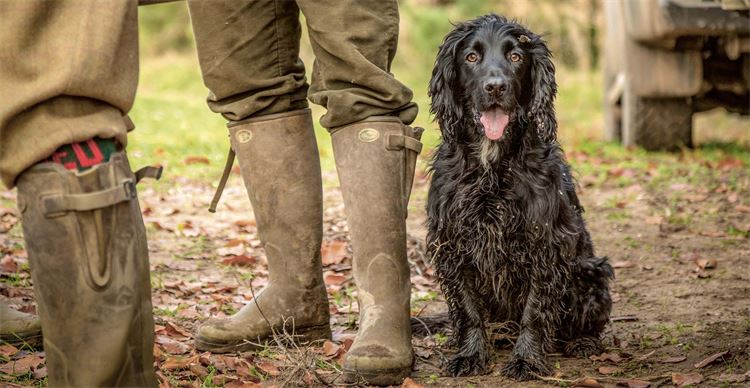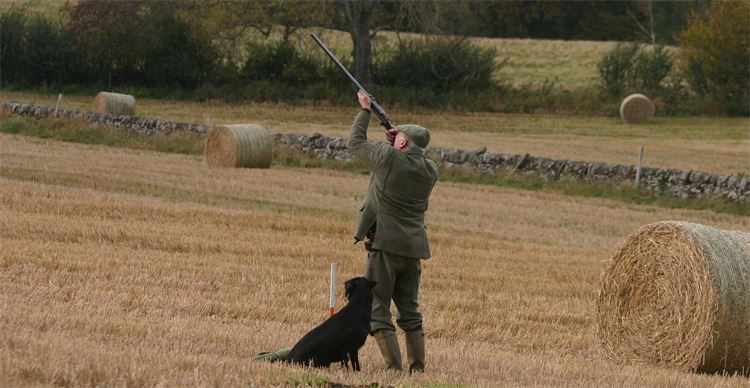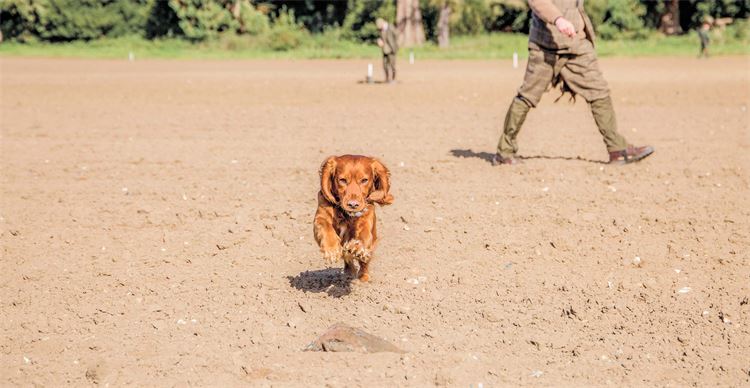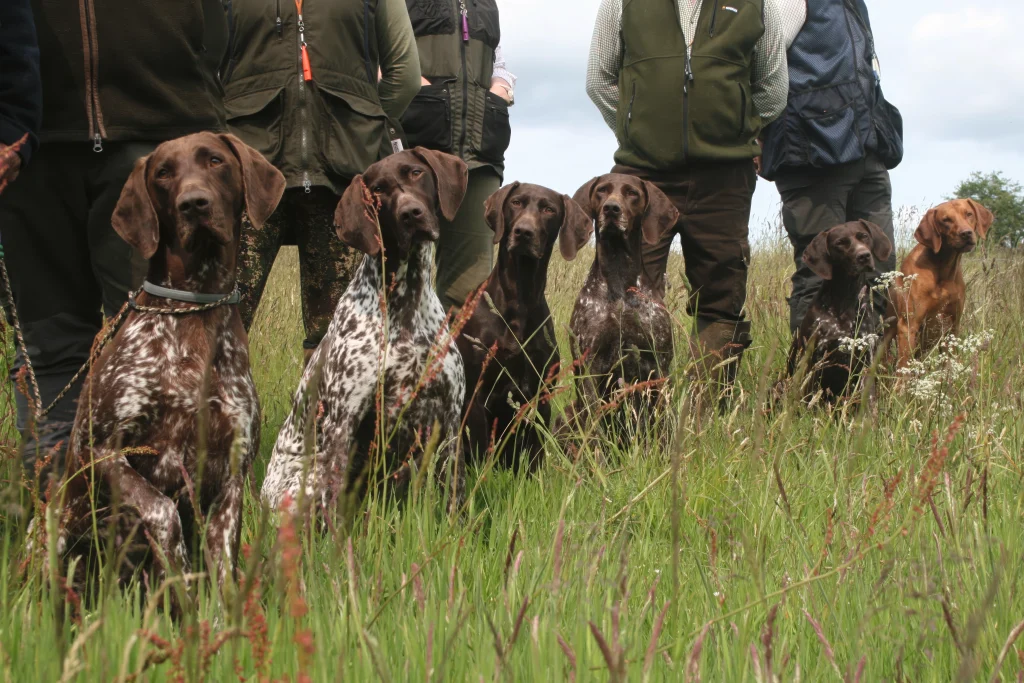A peg dog to be proud of
Field Editor Ben Randall advises on how best to shape a companion that will enhance rather than hamper a day’s shooting.
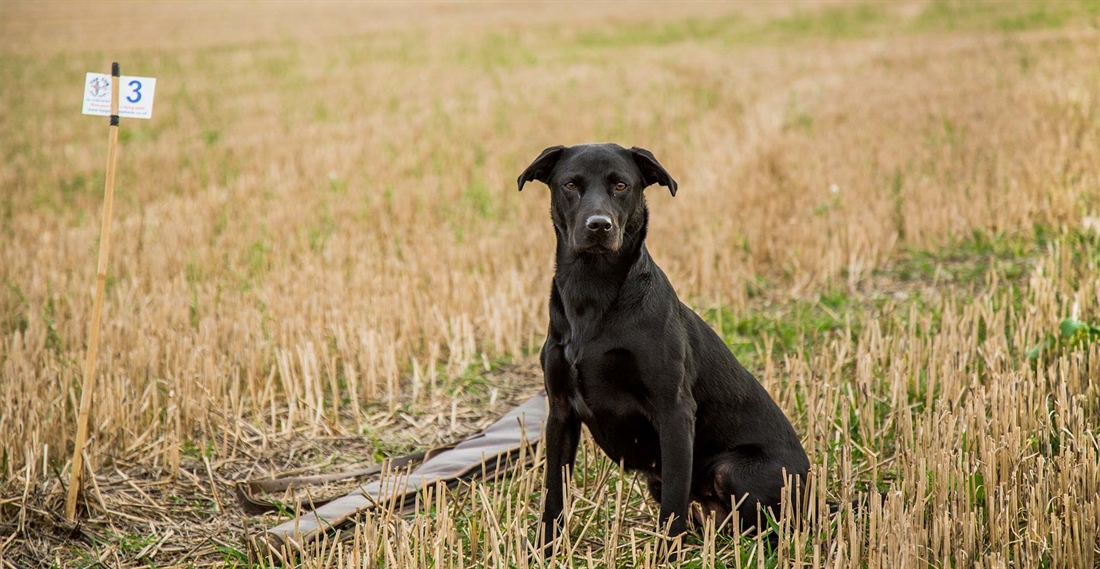
Immortalised in written accounts, tongue-in-cheek illustrations and cartoons since the advent of driven shooting, the scene of a ‘peg dog’ running riot mid-drive is typically portrayed as an amusing affair. But when ‘man’s best friend’– supposed to be sat quietly by his master in the line – runs amok on a shoot day, it can be far from a laughing matter.
To list what can go wrong, the majority of us game Shots need only sift through memories of past experiences in the shooting line. Hopefully, you will be thinking back to those occasions when a fellow Gun’s dog(s) – rather than your own – caused faces to turn crimson. Running-in, whining, swapping and stealing birds… any of these sound familiar? A good peg dog is the ultimate accessory for the sporting lady or gentleman, but a poorly trained, ill-behaved dog is nothing more than a liability, detracting from a shoot day that its owner and others have likely paid a lot of money for.
Now, I’m not for a minute suggesting that you should leave your dog at home until polished to perfection, but there are a few key principles which, if taken into consideration, will help you on your journey to training a peg dog to be proud of – a companion that will enhance your days in the field rather than hamper them.
Establishing a clear end goal for your dog’s training is a good place to start. Indeed, it’s surprising how many people buy a gundog without first giving thought to its intended role. The training of a peg dog, for example, will differ to the training of a dog that will be taken beating. I’d recommend sticking to one role and tailoring your training to this role from the outset. It is, of course, possible to train a ‘Jack of all trades’, but this generally requires a lot of time, good facilities and experience.
Put simply, all good peg dogs have the same basic set of attributes. They are patient, well-mannered, behave around other dogs and people, and will find and retrieve game without fuss. And, happily, all of these fundamentals can be honed from puppyhood…
Patience
From a young age, my dogs will be taught to sit, wait and watch as other dogs eat food or perform training exercises around them. This forms the basis of the patience and steadiness which is so important further down the line when it comes to the real thing. The key is to instil an attitude where the dog does not expect anything. Like spoilt children, spoilt dogs are such because they grow up getting everything they want – that might be endless retrieves, or even free reign of the family home with no rules or boundaries.
A dog that grows up expecting to be sent for every retrieve it sees, will be difficult to control in the shooting field – even more so when your focus is (supposed to be) on the shooting. Spoilt dogs swap retrieves, run in and generally do as they please.
A steady transition between different patience exercises, moving from food to dummies to real game, is a simple but hugely underrated process we can use to shape a calm and composed peg dog that sees being sent for a retrieve as a privilege, rather than a right. Exercises involving greater distraction and temptation should be introduced gradually as the dog matures and demonstrates its ability to remain calm and composed in the presence of temptation. You might, for example, progress from steadiness exercises with food and tennis balls in the garden, to patience training in the presence of experienced dogs, before then introducing new environments, sights and smells, and eventually moving on to brief spells where the dog will join you in a pigeon hide, simply to sit and learn to relax whilst you shoot.
Always keep the end goal in mind: a peg dog that will sit calmly in the line, watch birds fall and think ‘that’s not mine, that’s not mine, that’s not mine, but if I’m lucky I might be sent for one’, rather than ‘that’s mine, that’s mine, that’s mine, and even if you don’t send me for it, I’m going anyway!’.
Manners and social skills
It goes without saying that good behaviour around other people and dogs on a shoot day is essential. Ideally, our dogs will be nonchalant, paying little attention to others. A dog that rushes up to others excitedly throughout the day can be frustrating, but one which is aggressive is
a real problem and must be left at home until its behavioural problems have been resolved.
Good manners mean staying away from food at elevenses, not jumping up at people or into their vehicles, and remaining quiet between drives whilst in the dog box or gunbus. Socialisation with dogs and people in
a controlled and positive environment from a young age is key to achieving this.
Game finding and retrieving
There’s little point in investing the time and effort training a rock-steady gundog if it cannot find and retrieve shot game to hand. Choosing a pup from good stock with proven working ability helps. Once you have the right raw material to work with, then it is up to you to train the dog to be responsive to verbal and whistle commands, but without losing the confidence to use its own initiative.
By using an array of dummy shapes, weights and sizes as training progresses, we can prepare our dogs for cold game training with different quarry types – from mallard and redlegs to pigeons and snipe. You might encounter any of these species on a driven day, and it is nice to have a dog that will pick them all when given the opportunity.
The danger of haste
Before taking a dog to sit by your peg on a day’s shooting, it’s important that you are completely honest with yourself; is the dog really ready for the inevitable excitement? Believe me, energy levels are notched up several gears amidst the people, dogs, game, gunshot and perceivable excitement of most of those involved. If your dog can’t sit in the garden whilst others retrieve multiple balls and dummies around it, or sit calmly in a pigeon hide where there is just one person shooting, how do you expect it to fare when distraction and temptation are multiplied tenfold?
Take things in your own time and don’t succumb to peer pressure. It’s easy to ruin a gundog in haste; if you have to wait another season with a young dog before it is ready, then wait. It’s better to lose one year’s work and have seven good seasons thereafter, than start early and spend the rest of your dog’s life regretting the decision.
Cometh the hour
Over the years, I have seen Guns make nearly every mistake in the book when it comes to handling and working their peg dogs, but some errors certainly crop up more than others.
For the first few days you take your dog out on the peg, I’d strongly recommend you restrict your dog to one or two memory retrieves that you have placed yourself, and do not send the dog for birds that it has seen fall from the sky. By practising such restraint, it is possible to teach a dogs that not everything they see fall is for them to pick up, whilst further developing a calm and relaxed attitude.
A key piece of advice I’d give to a Gun who has decided to take a dog for a day in the line on a driven shoot, is to communicate effectively with the host, headkeeper, and head picker-up from the outset. This can save so much unnecessary stress (see page 140), make the day more enjoyable for everyone and, most importantly, ensure the best system is established for picking-up all game as ethically as is possible.
Shoots tend to differ in how they pick-up behind the line. Some will be quite hot on picking-up birds which fall near the Guns – in my book a big no, no – whilst others will only sweep through after concentrating on those birds that have fallen further back (how it should be done).
If you have a dog with you, tell your host that you would like to pick a few birds at the end of each drive before the picking-up team sweeps through. This way, you can relax in the knowledge that your peg dog, which has waited so patiently during the drive, will be rewarded with a retrieve or two, rather than be rendered redundant by an over-enthusiastic team of pickers-up.
Always wait until the drive is over until you begin working your own dog. If you have to walk out and dispatch a bird near your peg, then so be it, but any other birds can be left for the pickers-up to see to whilst you are still live on the peg, shooting. Then, once the horn has blown and the drive is over, calmly focus on one bird at a time. Your mindset is very important here, as dogs easily pick up on our moods and how tense or distracted we are. Stay relaxed – you are, after all, there to enjoy yourself.
Related Articles
Get the latest news delivered direct to your door
Subscribe to Gundog Journal
Unlock the full potential of your working dog with a subscription to Gundog Journal, the UK’s only dedicated magazine for gundog enthusiasts. Published bi-monthly, this authoritative resource delivers expert training advice, in-depth interviews with top trainers and veterinary guidance to help you nurture a stronger bond with your dog.
With stunning photography and thought-provoking content, Gundog Journal is your essential guide to understanding, training and celebrating your working dog.
Save 10% on shop price when you subscribe, with a choice of packages that work for you. Choose from Print & Digital or Digital only with each journal delivered directly to your door or via the app every other month, plus access to past issues with the digital back issue library.






